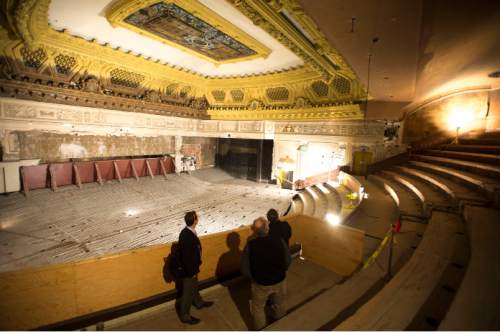This is an archived article that was published on sltrib.com in 2015, and information in the article may be outdated. It is provided only for personal research purposes and may not be reprinted.
Once an elegant matriarch among playhouses along Salt Lake City's Main Street, Utah Theater is more than showing her years these days.
To walk within those breathtakingly grand walls, their ornate finishings now falling to pieces, is to feel enchantment and disappointment at the same time, one city official said.
With a new prospect for having the 97-year-old downtown theater revamped and reintroduced to the public, leaders of the city's Redevelopment Agency opened the doors Thursday for an informal tour.
The stately, neoclassical lobby that led countless thrilled moviegoers along marble floors to their seats is now empty, silent and musty, with key decorative features torn out. Peeling paint dangles above water-damaged colonnades. Cherubs, gargoyles and lavish clusters of fruit rendered in plaster along wall corners and ceiling edges are dissolving to powdery gravel.
The stage where early 20th century stars such as Abbott and Costello, Will Rogers and baseball titan Babe Ruth once made audiences roar is stripped bare and lit by a theatrical ghost light.
"There's too much gone for us to consider a full restoration," said City Councilman Stan Penfold, who also chairs the city's urban-renewal agency. "But we can highlight what is left and hope we find a use that keeps it open to the public."
City officials recently entered into exclusive multiyear talks with a Utah restaurateur who hopes to bring the abandoned building back to useful life as an entertainment and dining center, possibly adding an office or residential tower on top. Joel LaSalle of the LaSalle Group, which owns Oasis Cafe, Faustinas and other popular eateries, now has up to three years to explore business opportunities the revamped theater and adjoining property could present.
The latest round of brainstorming on what might be restored, and to what end, has now begun in earnest. But the refreshed hope of a comeback for the aging treasure has at least one leading state historic preservationist excited.
Kirk Huffaker, executive director of Utah Heritage Foundation, called Utah Theater "a special place of cultural meaning in our downtown that people want to see worked back into the fabric of the city."
"It happens to have some extraordinary craftsmanship on the historic interior, and those are the significant pieces to save," Huffaker said. "If a project can't rise to the challenge of saving that interior, the wow factor everyone loves is gone."
Originally built in 1919 for vaudeville, what was then called the Pantages Theater served as a venue for top touring acts of that heyday before being converted to showing movies in the 1930s. Between the main hall and balcony, it sat more than 1,800 people. Generations of city residents saw major motion pictures of the day in the grandeur of the theater's vast auditorium.
The city bought Utah Theater in 2010 for $5.5 million and has since replaced the roof and made minor improvements, primarily to forestall further damage and for the safety of occasional visitors.
Concurrent to LaSalle's work, a city study is also underway on the theater's possible reincarnation.







